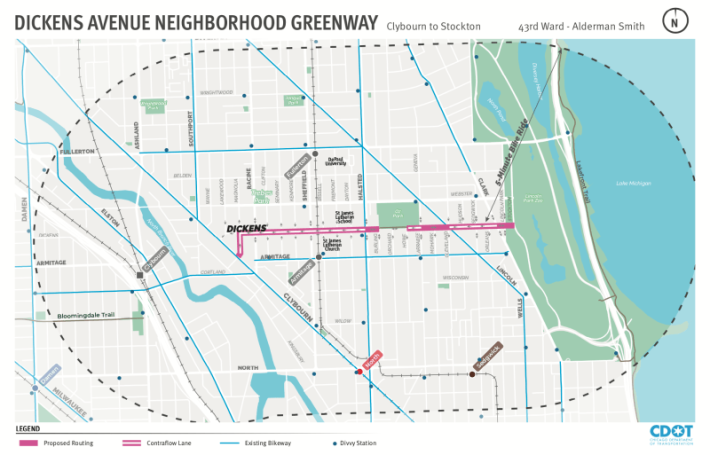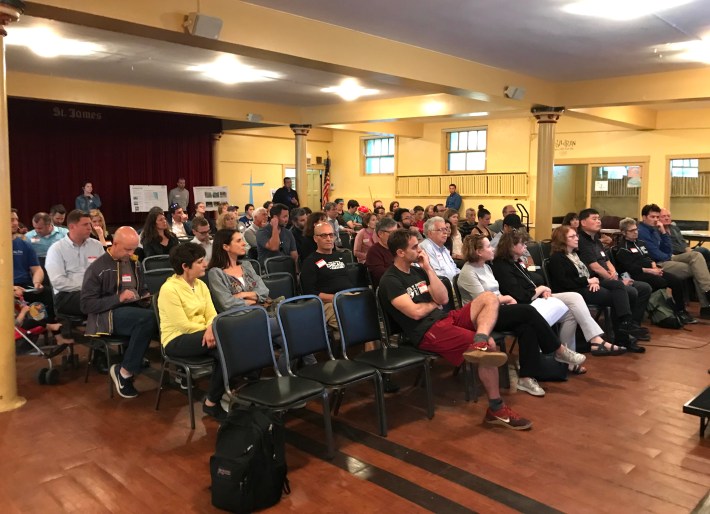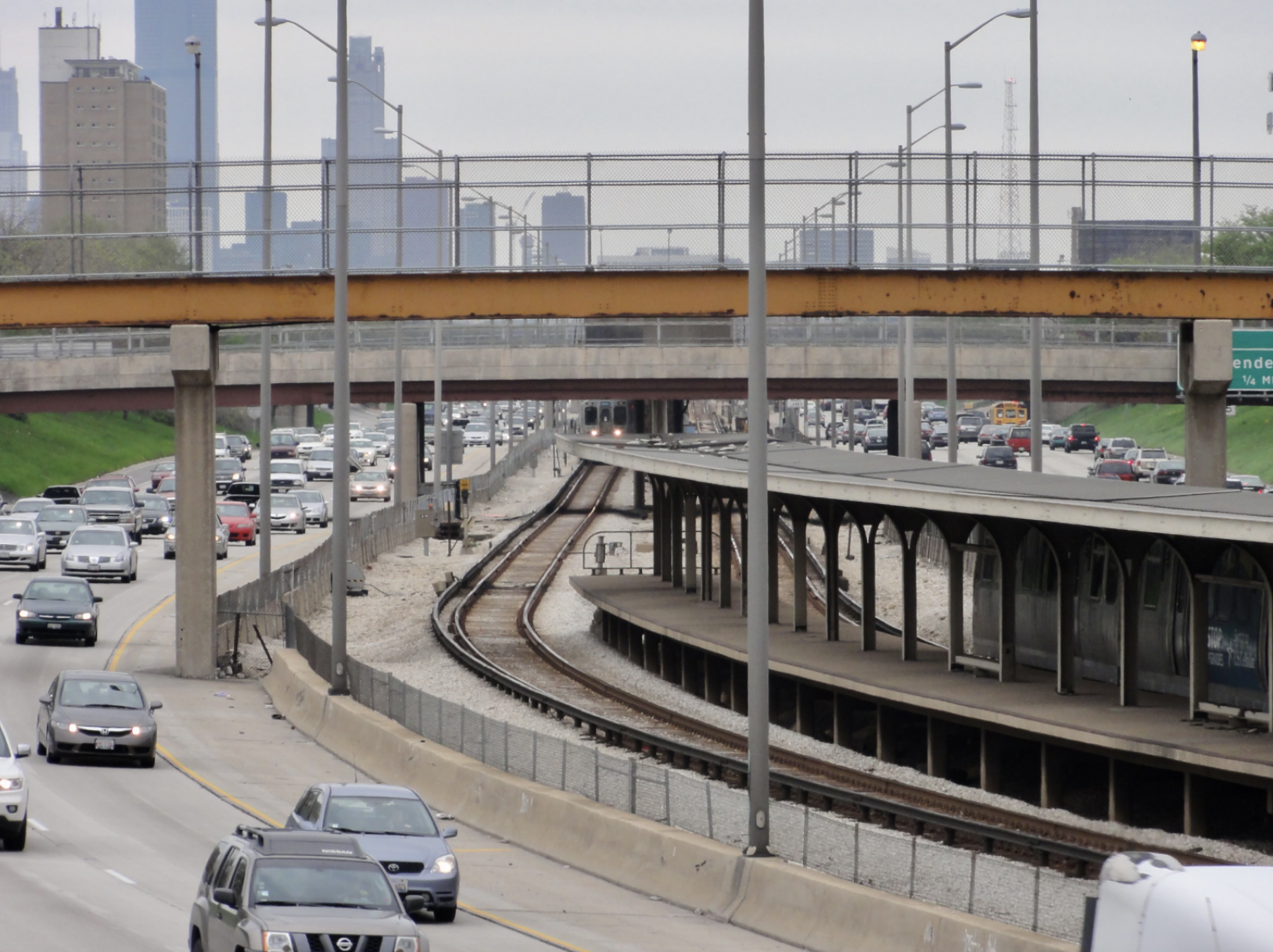Dickens Greenway NIMBYs Are More Worried About Being Hit by Cyclists Than Drivers
12:21 PM CDT on May 31, 2019

People riding bikes on Dickens Avenue last night. Photo: John Greenfield
Last year drivers killed 121 people on Chicago streets. 41 of the victims were pedestrians and five of them were cyclists.
In contrast, there is no record of a bicyclist fatally striking anyone in Chicago, ever.
But yesterday evening Lincoln Park residents acted as if the city's proposal to add traffic calming devices and bike lanes to Dickens Avenue, which would slow down people driving multi-ton vehicles, but encourage more people pedaling multi-pound bicycles to use the street, represents a major safety threat. Think about that for a minute.
To be honest, I had expected the community meeting on the Dickens neighborhood greenway proposal was going to be a short, lightly attended, uncontroversial hearing. After all, these quiet side-street bikeways are commonplace nowadays, with about 15 miles installed or currently under construction citywide. The greenways benefit all road users, as well as residents along the streets, by discouraging speeding by motorists, shortening pedestrian crossing distances, and creating low-stress, family-friendly bike routes.
Yes, the Dickens proposal includes a contraflow bike lane to allow for legal eastbound cycling on a street that's already a good westbound route. These "wrong-way" bikeways were somewhat controversial when they first debuted in Chicago several years ago, but nowadays they're all over the North and Northwest sides, on streets like Berteau, Glenwood, Albion, Juneway, and Wood. And the Chicago Department of Transportation says that crash rates have stayed the same or decreased on streets where they've been installed.
But comments from many of the dozens of attendees suggested they're afraid that increasing the amount of cycling on Dickens would put them and their children in mortal danger. In reality the traffic-calming infrastructure would almost certainly result in a net safety improvement.

Early in the meeting, held at St. James Lutheran Church, CDOT planner Dave Smith outlined the project, which would be mostly funded by a federal Congestion Mitigation and Air Quality Improvement grant. He noted that while Dickens is a block north of busy Armitage Avenue, which has bike lanes, "for a lot of people, that's just not comfortable enough" for cycling.
In addition to the contraflow lanes, the Dickens proposal calls for lowering the speed limit from 30 mph to 20, and adding pedestrian bumpouts to shorten crossing distances, bike-friendly speed humps, and/or raised crosswalks. Schools along the route, which runs between Clybourn and Stockton avenues, would get special attention. CDOT hopes to finalize the design and engineering by summer or fall of this year, but construction wouldn't start until late 2020 or early 2021 due to the federal funding process.
The original format for the meeting, scheduled to last only an hour, called for Dave Smith and local alderman Michele Smith (no relation) to field just a few questions from the audience before attendees were directed to check out display boards and talk with other CDOT reps. But there was an onslaught of negative feedback from neighbors which extended the Q & A session for the better part of an hour.
A few practical concerns were raised, such as questions of how adding sidewalk bumpouts would affect drainage, and how the bike lanes would coexist with drop-off and pickup times at St. James School. Smith responded that the sidewalk extensions could possibly include plantings or bioswales that would help manage storm water, and said CDOT is coordinating the project with the school and other local stakeholders.
But most of the comments reflected the misconception that making Dickens a more attractive place for cycling by slowing down motorized traffic and adding contraflow lanes would make things more, not less, dangerous for residents. "As a homeowner on Dickens, I know how bicyclists operate on this street -- they go so fast." said one woman. One man actually argued that people move to Dickens to get away from bike traffic, drawing a round of applause from other attendees.
"How many bicyclists have killed or hurt pedestrians compared to drivers?" shot back another attendee.

Alderman Smith told the crowd that she has been asking the city for a safer alternative to Armitage, which connects to Cortland Street and on to the Bloomingdale Trail, aka The 606, for seven years. "As a cyclist I'm terrified to ride on Armitage."
Some of the neighbors raised the specter of "fixie kids" riding down Dickens, especially if the Bloomingdale is extended east across the Chicago River as part of the nearby Lincoln Yards development. Coming from residents of one Chicago's wealthiest neighborhoods, statements that a new bikeway could attract a negative element from less wealthy neighborhoods to the west such as Humboldt Park and Logan Square, where fixed-gear cycles are popular with youth, carried a hint of classism.
Others said they were worried about directing cyclists to ride across the the southern edge of Oz Park on an existing path, which isn't a totally invalid concern. "It's hard for me to imagine how this is going to make Oz Park safer," said one senior. "You can put up all the signage you want and it's not going to work." One solution would be to add some "LOOK" pavement markings to alert pedestrians crossing the path to the presence of bike traffic, or perhaps install flexible posts or bollards on the edges of the path to raise awareness.
Dave Smith noted that the presence of the park is part of what makes Dickens a good candidate for a greenway, because it serves as a barrier to prevent drivers from using Dickens as a continuous cut-through route, making it a safer street for biking.

While somewhere around a dozen bikes bikes were parked outside the church, supporters of the plan were less vocal, but a few did speak up. "I'm super-excited about anything that has the word 'green' in the name," said one woman. "The more people who are on bikes, the less who will be in cars."
In light of the predominantly negative response, Alderman Smith promised to hold additional community meetings before moving forward with the project. But she noted that with tens of thousands of new residents moving to the area as part of the Lincoln Yards plan, it's going to be important promote cycling, because traffic is going to come to a standstill if all of them are primarily getting around by car. "We do know that the 606 is someday going to come across the river, and they're also planning a bike path along the river," she said. "That's maybe the only positive thing I'll say about Lincoln Yards."
You can send Alderman Smith feedback on the project via her director of communications: Rocio@ward43.org. We'll also keep you updated on future meetings.
In addition to editing Streetsblog Chicago, John writes about transportation and other topics for additional local publications. A Chicagoan since 1989, he enjoys exploring the city on foot, bike, bus, and 'L' train.
Read More:
Stay in touch
Sign up for our free newsletter
More from Streetsblog Chicago
Roger that! Streetsblog SF editor Roger Rudick shares his impressions of the Loop’s transportation scene
"Like so many cities, Chicago is obviously a work in progress," he accurately noted.
City announces $2M federal grant to address harms caused by I-290 by improving walk/bike/transit access
The Mayor's Office says the money will fund "improvements for people walking and bicycling on existing streets and paths surrounding and crossing the corridor."
Today’s headlines for Tuesday, April 16
CDOT reveals that it spent nearly $700K to install concrete protection on Doty bike lanes, and then remove it
Some of the former Doty bikeway curb protection was relocated to CDOT projects at Broadway/Aldine and on Wrightwood.



